 |

16 Feb 2011
|
|
Registered Users
Veteran HUBBer
|
|
Join Date: Aug 2002
Location: Utrecht, Netherlands
Posts: 147
|
|
|
Road conditions in East Africa
Previously I described on this bulletin board road conditions in West and Central Africa, from Morocco to Cape Town. Now I will describe the road conditions in East Africa. I traveled from Cape Town to Cairo but as most people do the Cairo to Cape Town trip I will describe the road conditions in this direction. As road conditions change over time and are depended of weather, I will mention time and weather for each country during my trip. Keep in mind that I traveled by motorbike.
A GENERAL ADVICE: don't pay (or bribe) police or other officials at checkpoints and at the borders. They ask sometimes for money but I never experienced serious pressure. If you have to pay, insist on a receipt. I never paid. By paying you make it more difficult for locals.
Egypt (January, February 2011; mostly dry weather)
Alexandria-Marsa Matrouh-Siwa Oasis (-Bahariya).
Alexandria-Cairo-Beni Suaf-Zafarana-Quseir-Qift-Luxor-Aswan.
Primary roads in Egypt are in good condition but secondary roads, which usually connects the villages, are old and less well maintained. However, no problem for driving. In recent years Egypt has developed a system of dual carriageways of good quality. The road from Matrouh to the Siwa Oasis is paved and in good condition. According to locals in Siwa the road between Siwa and Bahariya Oasis is in bad condition and partly covered with sand and sand dunes. Not recommended for motorbikes. You need a permit for that road.
Sudan (January 2011; dry weather)
Wadi Halfa-Dongola-Karima-Atbara-Khartoum-Wad Medani-Gedaref-Metema (border)-Gonder (Ethiopia).
Due to oil revenues in recent years Sudan has developed an extensive network of tarmacked roads of good quality in the northern part of the country. The road from Wadi Halfa to Dongola and Atbara is completely reconstructed and does not follow the original road so your GPS will tell you you are driving off road. The road from Gedaref over Metema (border) to Gonder (Ethiopia), which is indicated on most maps as 'earth road' and 'partially improved', is now tarmacked and in good condition.
Ethiopia (December 2010; mostly dry weather)
Metema-Bahir Dar-Gonder-Axum-Adigrat-Woldiya-Lalibela-Woldiya-Dese-Addis Abeba-Dilla-Moyale.
Ethiopia has in recent years greatly improved its road network. All major roads are sealed and in good condition. The road between Gonder and Axum till the town of Shire (about 60 km west of Axum) is still a dirt road but not too bad as long as it does not rain; road works were going on. The road from Axum over Adigrat and Woldiya to Addis Abeba (the eastern part of the historical loop) is tarmacked and in good condition, except for some sections between Axum and Adigrat and near Debre Birhan were road works were going on and detours exists. The road to Lalibela from the village of Dilbe near Woldiya was unpaved and very bad but might be better now as improvement had started. I took the road to Lalibela from the village of Gashena (between Woldiya and Bahir Dar) and that road was unpaved too but in much better condition. The road between Addis Abeba and Moyale is completely paved and in good condition. A warning: when I traveled in Ethiopia there was a serious fuel shortage (petrol). It might be temporarily but fuel up as you can. Be also warned for the massive amounts of cows, goats, donkeys, children which all want to cross the road.
Kenya (November 2010; rain season)
Moyale-Marsabit-Isiolo-Nairobi-Eldoret-Kitale.
The road in northern Kenya is of major concern to most travelers. It is unpaved and in bad condition. The section from Moyale to the village of Torbi, where the road turns to south, the road surface is loam, sometimes covered with sand, muddy spots and corrugated but this is still the best part. In Torbi is a basic hotel and opposite is the Small World Bar, were you can get a beer. From Torbi to Marsabit National Park the road surface consists of sharp edged stones; difficult to drive and punctures are the main risk. It is a desert so take water with you in case you get a puncture. In Marsabit National Park the road surface changes to loam, with spots of large boulders which are not difficult to pass by motorbike but might be nasty for cars. During dry weather the loam surface is hard and easy to drive but in wet conditions it is a terrible mud pool. I was there during rain and it was not funny. From Marsabit National Park southward the road is sand, sometimes deep sand, and loam and corrugated as between Moyale and Torbi. This will last until you reach the southern boundary of Losai Nature Reserve about half way between Marsabit and Isiolo. There the tarmac starts all the way down to Nairobi. The road from Nairobi to the Ugandan border is tarmacked and very buzzy. West of Eldoret until the border the road is in bad condition, with deep spurs. Although the army was largely relocated to the Northeast, to the border with Somalia, and locals warned for banditry, I had no security problems in the north of Kenya. It was safe, at least during day time. However problems might exist at the end of the dry season when the nomads become desperate.
Uganda (October 2010, rain season)
Eldoret-Tororo-Mbale-Tororo-Kampala-Murchison Falls National Park-Kampala-Fort Portal-Kasese-Mbarara-Kabale.
The roads in Uganda are generally in reasonable good condition. The Ugandan government has started an extensive road reconstruction program so expect road works. The road from Kampala to Murchison Falls NP is tarmacked till the city of Masindi. From Masindi to MFNP it is a loam road (murram). Very good in dry season but might be impossible to pass by motorbike during rain season, especially later in the rain season when the road body is soaked with water. The road from Kampala to Fort Portal is tarmacked and in good condition except for the first fifty kilometers which were under reconstruction and very dusty. From Fort Portal I crossed Queen Eliyabeth National Park over Mbarara to the Rwandan border. This road is good and nice to drive; beautiful landscape. Don't take the shortcut to bypass Mbarara during rain as this shortcut might turn into a mud pool.
Rwanda (September, October 2010; rain season)
Kabale-Kigali-Gisenye-Gitarama-Butare (Huye)-Cyangugu-Butare-Kigali-Rusumo (border with Tanzania).
The main road network in Rwanda is in good condition. No problem, except the road between Butare (Huye) and Cyangugu, through the forest of Nyungwe in the south of Rwanda. This road is tarmacked but covered with potholes. It is okay to drive but you have to be aware of this. In Butare I recommend hotel Mont de Huye. It is easily the best place in town to stay: cheap, comfortable, friendly and with a courtyard to park your car or bike. Location: S 02.36.177 E 029.44.543.
Tanzania (September 2010, dry season)
Rusumo (border with Rwanda)-Kahama-Mwanza-Nzega-Singida-Arusha-Moshi-Dar es Salaam-Iringa-Mbeya-Kaporo (Malawi).
Road conditions in Tanyania are in general not that good. In sixty years of independence and billions of aid this country has not succeeded in constructing even a paved road network which connects the major cities. The road from Rusumo, at the border with Rwanda, until Kahama is tarmacked but under reconstruction with detours and temporary side roads. From Kahama to Mwanza and back to Nzega till Singida the road surface is in good condition; new tarmac. From Singida to Babati, at the junction with the main road between Arusha and Dodoma, the road is under reconstruction and horrible: sand, loam, deep potholes, boulders, corrugation; everything most people don't want. The main road between Arusha and Dodoma, from the village of Makuyuni on, is under reconstruction too but not as bad as the road from Singida to Babati. From Makuyuni to Arusha the road is tarmacked. The road from Arusha over Moshi to Dar es Salaam is okay, tarmacked but with potholes. The road from Dar es Salaam over Iringa to Mbeya is very buzzy, quite dangerous due to murderous truck and bus drivers and between Mikumi and Iringa under reconstruction. There are small detours and traffic jams. From Mbeya to Kaporo in Malawi the road is good. Halfway between Mbeya and Kaporo, in the village of Tukuyu, is a good and reasonable priced hotel. It is named Landmark Hotel; you can't miss it. Locals warned for the security situation on the road down to Kibondo and Kigoma near the Burundi border due to banditry. Many refugee camps exist near the borders with Rwanda and Burundi.
Malawi (August 2010, dry season)
Kaporo-Mzuzu-the lakeside road to Cape Maclear and Liwonde-Blantyre-Mwanza (border with Mozambique).
The main road network in Malawi is in good condition. Be aware of cattle and people crossing the road. The road from Chitimba up to the missionpost of Livingstonia is very steep, hairpinned and in bad condition. There is not that much to see in Livingstonia, other mission posts in Malawi are more interesting. If you visit Cape Maclear at Malawi Lake, do a bit of bird watching with Steady Jalie. He is an excellent guide and a pleasant guy. You can contact him through Fat Monkeys Lodge or by phone (+265 999 313 509).
Mozambique (August 2010, dry season)
Mwanza (border with Malawi)-Tete-Changara-Mutare (Zimbabwe).
I just crossed so I have little experience with road conditions in Mozambique. The road from the Malawi border to the Zimbabwan border was good but there was a fuel shortage.
Zimbabwe (august 2010, dry season)
Mutare-Masvingo-Harare-Chirundu (border with Zambia).
All roads were good. Old and repeatedly repaired tarmac but okay. Not much traffic. Decent traffic behaviour.
Zambia (august 2010, dry season)
Chirundu-Lusaka-Livingstone-Kazungula (border with Botswana).
The road was okay, tarmacked, sections with big and deep potholes.
Botswana (May and July 2010, dry season)
Mahango (Caprivistrip)-Ghanzi-Gobabis (Namibia). Kasane-Katima Mulilo-Mahango-Maun-Nata-Francistown-Gaborone-Lobatse (border South Africa).
The main road network in Botswana is in good condition; tarmacked, some potholes. No fuel problems.
|

16 Feb 2011
|
|
Registered Users
Veteran HUBBer
|
|
Join Date: Aug 2005
Location: Calgary AB
Posts: 1,028
|
|
|
What do you think your top and average speed on the sealed roads is/ was?
|

17 Feb 2011
|
|
Registered Users
Veteran HUBBer
|
|
Join Date: Aug 2002
Location: Utrecht, Netherlands
Posts: 147
|
|
|
speed
80 km/h on average. I am quite slow. 
|

17 Feb 2011
|
 |
Registered Users
Veteran HUBBer
|
|
Join Date: Sep 2001
Location: Portugal
Posts: 1,134
|
|
|
Sorry, what is a 'loam' road?
ie: From Masindi to MFNP it is a loam road (murram).
|

17 Feb 2011
|
|
Registered Users
Veteran HUBBer
|
|
Join Date: Oct 2004
Location: London
Posts: 542
|
|
|
Loam / laterite / murram is an earthy red clay surface.
Good in the dry, but horrible in the wet.
|

8 Mar 2011
|
|
Registered Users
HUBB regular
|
|
Join Date: Jun 2009
Location: Didcot
Posts: 54
|
|
Nairobi is best avoided as the traffic is dreadful, grilocked and made worse by the massive re-engineering going on with new flyovers and roundabouts, the tarmac improvements going north are to extend further in 2012, not as far as Marsabit, but there will be a lot less dirt-road next year. There are improvements planned for the "road to hell" through the desert north of Marsabit to Moyale in late 2012, this has to be one of the roughest roads in Africa.
Got through in an early Freelander (!) on fairly ordinary van-type tyres, (5 ply casing, 2-ply sidewalls) with no punctures, but met one overlander who had 14 and a biker who had 9. Take a tyre compressor so you can lower the tyre pressures on the corrugations (50 km south of Moyale if you are heading north, all the way to the town), and increase them for the seriously rough stuff.
Sudan following the Nile is now brilliant tarmac (as is the road to the border through the mountains of Ethiopia, a stunning drive).
Diary is up at www.londoncapetownrally.com
The Egypt ferry is just shocking, given there are three very good roads to the border and the Sudan-side are keen to see them open to normal traffic and trade.
There is a little known hostel in Wadi Halfa called the VIP House, you have to ask for it, a single storey building on the southern edge of the town, and its five very good bedrooms with good facilities, and vastly better than any alternative, inside a walled courtyard and very secure.
Completed London to Cape Town in six weeks - no bribes given, or, asked for, not even a biro.
The "police permit" or authorsiation in Wadi Halfa is a scam, if they wont give you a receipt, walk away (and they wont try to stop you), not convinced this is necessary as it was never asked for in the whole crossing of Sudan (via Khartoum, best place to stay is a small hotel behind the Lebanese Restaurant in the one-way-system part of Africa Street), very friendly helpful people everywhere, and so much more "modern" than Egypt, where locals seem to be more industrious and working hard to make a success of their lives instead of sitting around.
The road from Arusha south to Dodoma is hard in places but do-able, the first 150km is all new tarmac which is steadily being extended. Dodoma immediatelty south is also a go-er, tricky mountain climb in the middle, the alternative of going east almost to Dar is a busy road full of trucks, nothing like as interesting.
|

16 Mar 2011
|
|
Registered Users
HUBB regular
|
|
Join Date: Aug 2009
Location: Belgium
Posts: 50
|
|
Quote:
Originally Posted by martheijnens

The road from Wadi Halfa to Dongola and Atbara is completely reconstructed and does not follow the original road so your GPS will tell you you are driving off road.
|
Do you have tracks of it ?
__________________
R 1200 GS '08 en G 650 X Challenge '08
|

17 Mar 2011
|
|
Registered Users
Veteran HUBBer
|
|
Join Date: Aug 2002
Location: Utrecht, Netherlands
Posts: 147
|
|
|
Track NE Africa
I attached to this message the track of northeast Africa. Points are made every 5 km.
Mart
|

17 Mar 2011
|
|
Registered Users
HUBB regular
|
|
Join Date: Aug 2009
Location: Belgium
Posts: 50
|
|
Nice ! Thank you 
You drove from south to north. Where and how did you get your visas ?
My bike is now in Cape Town after driving it south from Belgium at the west side.
In August I will drive it back home at the east side.
__________________
R 1200 GS '08 en G 650 X Challenge '08
|

18 Mar 2011
|
|
Registered Users
Veteran HUBBer
|
|
Join Date: Aug 2002
Location: Utrecht, Netherlands
Posts: 147
|
|
|
Visa
Hi,
Compared to the countries in West Africa to get visa for East African countries is quite easy. For most countries you can get the visa at the border: Botswana, Zambia, Zimbabwe, Mozambique, Malawi, Tanzania, Uganda, Kenya. There are some exceptions.
RWANDA. According to fellow-travelers the visa for Rwanda has to be applied at the embassy in Tanzania but I got the Rwandese visa simply at the border. For Belgian travellers it seems to be difficult to get a visa for Rwanda.
ETHIOPIA. Travelling from south to north the only place to apply for the Ethiopian visa is at the embassy in Harare, Zimbabwe. My visa was issued the same day and without any hassle. The Ethiopian embassies in Kampala and Nairobi don't issue visa anymore! Travelling from north to south a visa can be applied in Khartoum. There are problems regarding the usage of the Carnet de Passage. Travelling from north to south, from Sudan to Ethiopia, the carnet is not accepted. You need a letter of guarantee from your embassy in Addis Abeba. Travelling from south to north the carnet is accepted and I didn't need a letter of guarantee. This regulation was introduced suddenly in may or june 2010.
SUDAN. I got the visa for Sudan from the embassy in Nairobi, Kenya. A letter of recommendation of your embassy is demanded but I got the visa without a letter. Visa was issued the next day after appliance. If travelling from north to south apply in Cairo.
EGYPT. I got the visa from the Egyptian embassy in Khartoum. However visa were issued too on the ferryboat from Wadi Halfa to Aswan.
Visa cost generally about 50 to 60 US dollar. You facilitate your appliance if you are dressed decendly: no short trousers, no blue jeans, no sandals, no t-shirt, shaved. When I applied for a visa at the Sudanese embassy in Nairobi a British couple was denied, probably because they were dressed in short trousers and sandals. The Gabonese embassy in Yaounde, Cameroon, refused two Chinese because they were dressed in blue jeans (black jeans were no problem).
Have a good trip.
|

26 Sep 2011
|
|
Registered Users
New on the HUBB
|
|
Join Date: Sep 2011
Posts: 4
|
|
|
Thank you to all that shared their knowledge and experience.
I just wanted to know roughly how much unpaved road should be expected in a trip from Cape Town to Cairo, is it mostly paved with only a handful of unpaved sections extending a few 10s of kms at a time or are there sections where I would have to spend days on end on unpaved roads or as I suspect, is it somewhere inbetween and if so to what extend?
I'm talking about taking the most direct route with little diversions as I see fit, but essentially if I wanted to avoid unpaved as much as possible how much should I expect to HAVE to ride on?
I hope that is clear, I am planning on deviating from the main road, but wanted to know if I am having an aweful time, what I can get away with to just finish the trip.
Thanks,
Stu.
|

27 Sep 2011
|
|
Registered Users
Veteran HUBBer
|
|
Join Date: Aug 2002
Location: Utrecht, Netherlands
Posts: 147
|
|
|
If you don't want, you don't need to drive unpaved roads from Cape Town to Cairo, except for the northern part of Kenya, between Isiolo and Moyale. However from Isiolo northward there is still about 150 km newly paved road and from Moyale southward road construction has started. Now you have to drive only about 350 km unpaved. The section between Marsabit and the village of Torbi (200 km) is the most difficult, very stony (punctures!). See my first message in this thread.
Mart Heijnens
|
|
Currently Active Users Viewing This Thread: 1 (0 Registered Users and/or Members and 1 guests)
|
|
|
| Thread Tools |
|
|
| Display Modes |
 Hybrid Mode Hybrid Mode
|
 Posting Rules
Posting Rules
|
You may not post new threads
You may not post replies
You may not post attachments
You may not edit your posts
HTML code is Off
|
|
|
|

Check the RAW segments; Grant, your HU host is on every month!
Episodes below to listen to while you, err, pretend to do something or other...

2020 Edition of Chris Scott's Adventure Motorcycling Handbook.
"Ultimate global guide for red-blooded bikers planning overseas exploration. Covers choice & preparation of best bike, shipping overseas, baggage design, riding techniques, travel health, visas, documentation, safety and useful addresses." Recommended. (Grant)

Led by special operations veterans, Stanford Medicine affiliated physicians, paramedics and other travel experts, Ripcord is perfect for adventure seekers, climbers, skiers, sports enthusiasts, hunters, international travelers, humanitarian efforts, expeditions and more.
Ripcord Rescue Travel Insurance™ combines into a single integrated program the best evacuation and rescue with the premier travel insurance coverages designed for adventurers and travel is covered on motorcycles of all sizes.
(ONLY US RESIDENTS and currently has a limit of 60 days.)
Ripcord Evacuation Insurance is available for ALL nationalities.
What others say about HU...
"This site is the BIBLE for international bike travelers." Greg, Australia
"Thank you! The web site, The travels, The insight, The inspiration, Everything, just thanks." Colin, UK
"My friend and I are planning a trip from Singapore to England... We found (the HU) site invaluable as an aid to planning and have based a lot of our purchases (bikes, riding gear, etc.) on what we have learned from this site." Phil, Australia
"I for one always had an adventurous spirit, but you and Susan lit the fire for my trip and I'll be forever grateful for what you two do to inspire others to just do it." Brent, USA
"Your website is a mecca of valuable information and the (video) series is informative, entertaining, and inspiring!" Jennifer, Canada
"Your worldwide organisation and events are the Go To places to for all serious touring and aspiring touring bikers." Trevor, South Africa
"This is the answer to all my questions." Haydn, Australia
"Keep going the excellent work you are doing for Horizons Unlimited - I love it!" Thomas, Germany
Lots more comments here!

Every book a diary
Every chapter a day
Every day a journey
Refreshingly honest and compelling tales: the hights and lows of a life on the road. Solo, unsupported, budget journeys of discovery.
Authentic, engaging and evocative travel memoirs, overland, around the world and through life.
All 8 books available from the author or as eBooks and audio books
Back Road Map Books and Backroad GPS Maps for all of Canada - a must have!
New to Horizons Unlimited?
New to motorcycle travelling? New to the HU site? Confused? Too many options? It's really very simple - just 4 easy steps!
Horizons Unlimited was founded in 1997 by Grant and Susan Johnson following their journey around the world on a BMW R80G/S.
 Read more about Grant & Susan's story
Read more about Grant & Susan's story
Membership - help keep us going!
Horizons Unlimited is not a big multi-national company, just two people who love motorcycle travel and have grown what started as a hobby in 1997 into a full time job (usually 8-10 hours per day and 7 days a week) and a labour of love. To keep it going and a roof over our heads, we run events all over the world with the help of volunteers; we sell inspirational and informative DVDs; we have a few selected advertisers; and we make a small amount from memberships.
You don't have to be a Member to come to an HU meeting, access the website, or ask questions on the HUBB. What you get for your membership contribution is our sincere gratitude, good karma and knowing that you're helping to keep the motorcycle travel dream alive. Contributing Members and Gold Members do get additional features on the HUBB. Here's a list of all the Member benefits on the HUBB.
|
|
|